
All images © by Roberto Piperno, owner of the domain. Write to romapip@quipo.it.
Notes:
Page added in October 2025.

All images © by Roberto Piperno, owner of the domain. Write to romapip@quipo.it.
Notes:
Page added in October 2025.
 Volterra - Churches and Paintings
Volterra - Churches and PaintingsYou may wish to read a page on Medieval Volterra first.
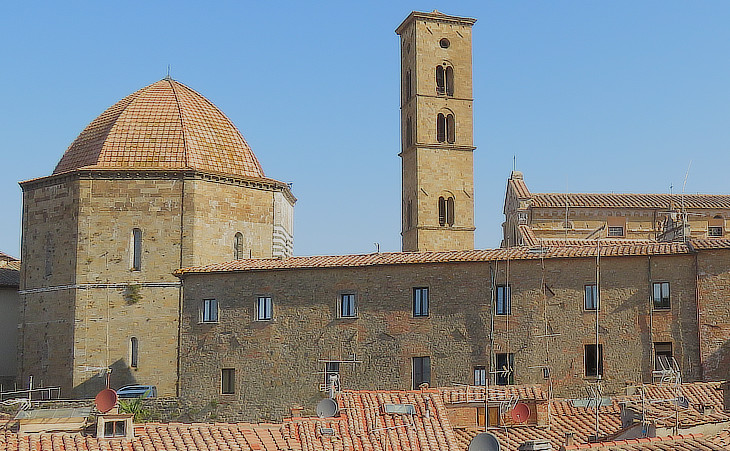
It is quite natural that Pisa, with her incomparable
groups of architectural monuments (Cathedral, Campanile
and Baptistery), was bound to appeal deeply to the
imagination. The monuments of
Sardinia are Pisan; as well as many churches in other
districts; in the neighbouring Lucchesia, in Pistoia, Volterra and S. Gimignano, and further south in Massa
Marittima.
Corrado Ricci - Romanesque Architecture in Italy - 1925.
Being a historical major town Volterra became a bishopric see and a long list of its bishops is recorded since the Vth century. In the XIth century the bishops acquired an important role in the administration of the town and the construction of the Cathedral and of the adjoining monuments testifies to their power.
Pisa, with her innumerable arcaded galleries, her multicoloured fasciae and rhomb patterns (see a detail of its Cathedral - it opens in another window), finds imitators throughout Italy. Ricci
The Cathedral, consecrated by Calixtus II. in 1120, was enlarged in 1254 by Niccol˛ di Pisa, and restored and embellished in the sixteenth century by Leonardo Ricciarelli, a nephew of Daniele da Volterra. The fašade is entirely of the thirteenth century, but the door of black and white marble appears to be more recent.
John Murray - Handbook for travellers in Central Italy - 1843
I don't care about the cold cathedral, though it is rather nice really, with a glow of duskycandles and a smell of Sunday incense: I am disappointed in the wooden sculpture of the taking down of Jesus, and the bas-reliefs don't interest me.
David Herbert Lawrence - Etruscan Places - Published in 1932, but based on a visit made in April 1927.
Part of the rear side of the Cathedral can be seen in Piazza Maggiore, next to the Town Palace. The image used as background for this page shows a relief in the portico of the former Spedale di S. Maria Maddalena opposite the Cathedral.
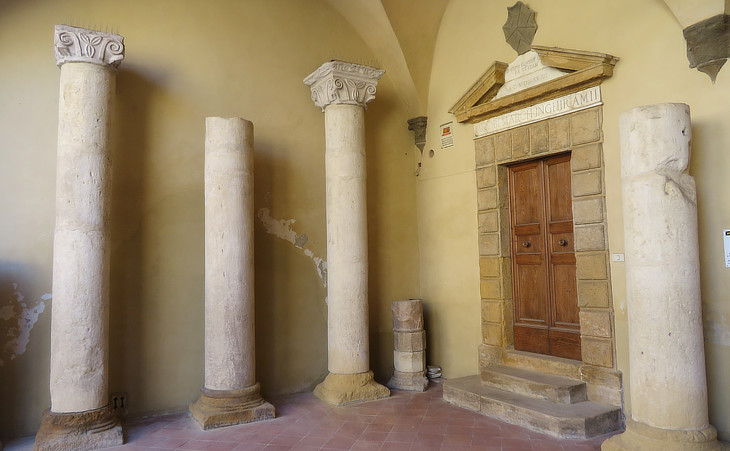
I formed many acquaintances at Volterra, and spent the interval of my stay very agreeably. I was lodged in the house of my friend Marcello Inghirami.
Richard Colt Hoare - A classical tour through Italy and Sicily - publ. in 1819
In the chapel of St. Paul belonging to the Inghirami family, are the fine frescoes of Giovanni di S. Giovanni, illustrating the history of St. Paul, and the painting representing his conversion, by Domenichino, much injured by the retouching of Franchini and others. (..) This chapel was built in 1615 by Gen. Jacopo Inghirami, a celebrated captain of the sixteenth century, called the "flagello de' Barbereschi e de' Turchi." Murray
The Inghirami family has left a mark on the history of Volterra with achievements across various fields - from politics to culture, from diplomacy to warfare (see a portrait of Tommaso Inghirami, a Renaissance humanist and orator by Raphael).
Perhaps the most celebrated member of the family, Jacopo joined the Order of Santo Stefano in 1581 and mastered military arts under the French crown. He was later appointed Admiral of the Order's fleet and brought enduring glory to the small Tuscan navy with numerous naval victories, such as the capture of fortresses in Albania, Greece, and on the Barbary Coast (Tunisia and Algeria). His most brilliant feat was the capture of Bona, today's Annaba in Algeria. In recognition of his achievements, Grand Duke Ferdinand I granted him a fiefdom with the title of Marquis. The capture of Bona is celebrated in an equestrian statue of Ferdinand in Florence.
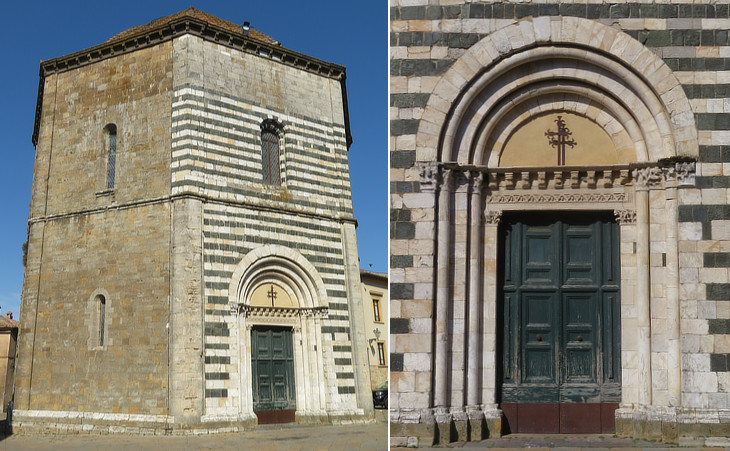
.. il mio bel S. Giovanni (my beautiful Saint John)
Dante - Inferno Canto XIX, 17 with reference to the Baptistery of Florence, and also that of Volterra is named after St. John the Baptist.
The neighbouring church of S. Giovanni, supposed to occupy the site of a Temple of the Sun, is an octagonal Gothic building, referred to the seventh century. The doorway of black and white marble is very curious, and the capitals of the Gothic columns are full of animals and birds. Murray
its octagonal shape is typical of Italian baptisteries and it derived from that of Battisterio Lateranense aka S. Giovanni in Fonte in Rome and from those of two baptisteries of Ravenna, that of Neon and the Arian one.
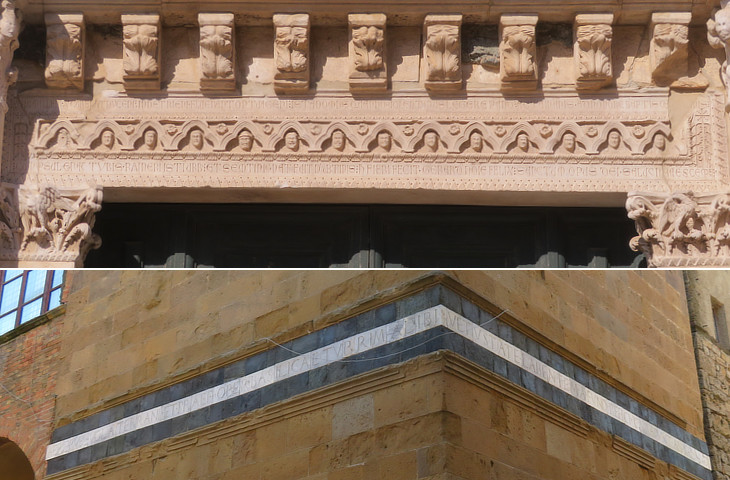
Over the architrave are thirteen heads in bas-relief representing the Virgin and the Twelve Apostles (the heads are 14 because there is also one portraying Jesus). Murray
The relief is very finely sculptured: two letters in each small niche identify the Apostle who is portrayed i.e. AN(drew), PE(ter). A long inscription above and below the heads indicates that the building was restored in 1283 at the initiative of Bishop Ranieri II Ubertini who belonged to a powerful family of Arezzo.
Another well written inscription at the base of the bell tower states that in 1493 the citizens (Republ. Volaterrani) and the institution in charge of the Cathedral (Oper. Basilicae) restored the building which was about to collapse.
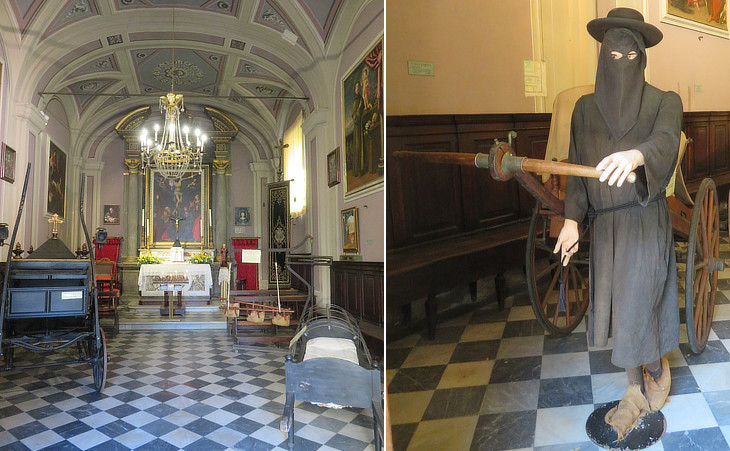
In most Tuscan towns when you need an ambulance, you do not call the Red Cross, you call "La Misericordia" (Mercy), a brotherhood for helping the sick. In Florence it was founded in 1244 and its members wore the traditional hooded uniform until 2006. The Florentine community in Rome had a similar brotherhood at S. Giovanni Decollato. That of Volterra, one of the oldest ones, was founded in 1291 and it is still active with more than 80 active members and one thousand supporters.
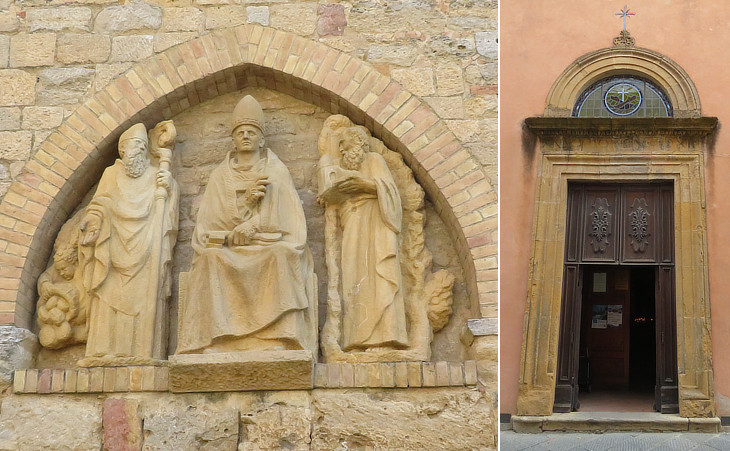
The church and monastery of San Lino were founded in 1480 by Raffaello Maffei, and finished in 1517, at the cost of 80,000 scudi. It contains the tomb of the founder, erected by his brother Mario. (..) Raffaello Maffei was born at Volterra in 1451. He obtained considerable reputation as a theologian and philosopher; he was the founder of the Accademia Letteraria de' Sepolti, the author of the "Commentariorum Urbanorum" dedicated to Julius II., and the translator of the Odyssey. Murray
Raffaele Maffei claimed in his "Commentariorum Urbanorum", a sort of encyclopaedia, that Saint Linus, the second pope, was born at Volterra and he promoted the construction of a church dedicated to him. He did not provide any documentation supporting his claim, but the saint was included among the patrons of the town. According to a local traditional account St. Peter, on his way to Rome from Jerusalem, landed at Pisa where a large basilica (S. Piero a Grado - it opens in another window) was erected on the site where he disembarked and Maffei built on it to support his opinion.
The church of S. Francesco, founded in the thirteenth century by the Comune and citizens, was reconstructed in 1623, and has undergone many subsequent alterations. It contains several tombs of the Guidi family, among which is that of Jacopo Guidi, bishop of Penna and Atri, the pupil of Guicciardini, with whom he was sent on a mission from Cosmo I. to the courts of Madrid and Paris. (..) The celebrated Mario Guarnacci, founder of the museum, and one of the very earliest Etruscan scholars, is buried here. His tomb was erected in his lifetime. (..) Adjoining this church is the Gothic chapel belonging to the Confraternita della Croce di Giorno, built in 1315. The interior is covered with frescoes. On the blue vault studded with stars are the four Evangelists, by Jacopo da Firenze (Orcagna?), in 1410. Murray
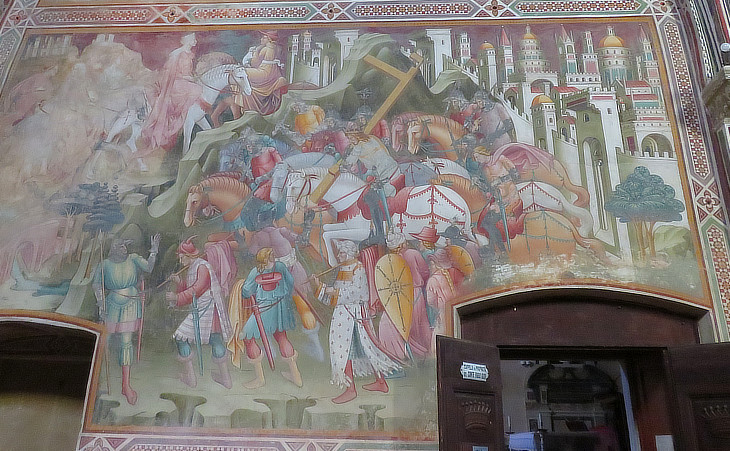
The walls, painted according to the inscription by Cenno di Francesco di Ser Cenni, represent the Massacre of the Innocents, the Recovery of the True Cross, &c. This Cenno di Ser Cenni is supposed to be Cennino da Colle, the pupil of Agnolo Gaddi. Murray.
The frescoes were inspired after those painted by Agnolo Gaddi in the church of S. Croce in Florence. The cycle of the Story of the True Cross was painted in 1452-1458 by Piero della Francesca at Arezzo in another Franciscan church and the comparison between the two cycles testifies to the rapid progress of Italian painting in the XVth century.
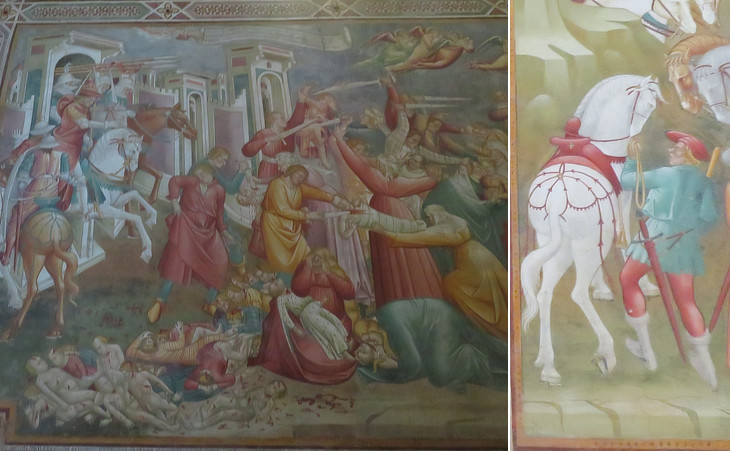
In his frescoes the painter alternated very crowded scenes with gruesome images of fight and death with some elegant details illustrating aspects of the life and practices of his time.
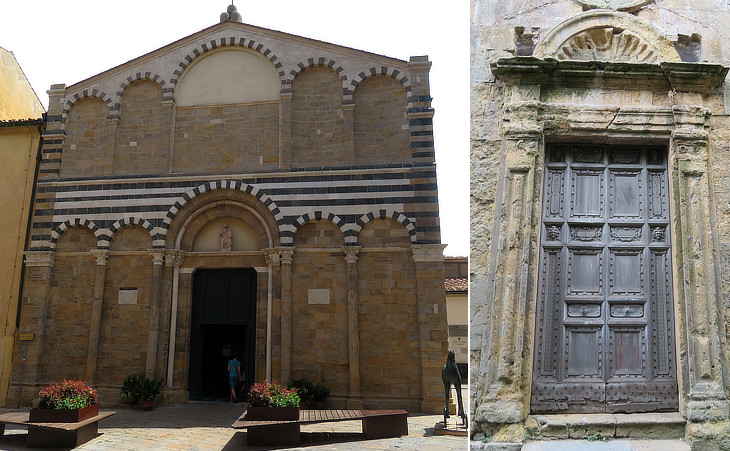
The decline of Volterra after 1530, when its citizens made a failed attempt to free themselves from the Medici government is testified to by the lack of churches built afterwards. The interior of the existing ones however was very often redesigned and decorated with new monuments and paintings.
April 1790. Some good works of the Florentine school are to be found in the churches.
Richard Colt Hoare - A classical tour through Italy and Sicily - publ. in 1819
The secularization of some churches, the collapse of others in the ravine and the closure of monasteries put in danger the conservation of the artistic heritage of Volterra. At the beginning of the XXth century a Civic Gallery of Paintings was established inside Palazzo dei Priori. It was relocated to Palazzo Minucci Solaini in 1982. The palace was built in the XVIth century and it retains some evidence of its decoration, although in the XIXth century it was split into apartments and workshops.
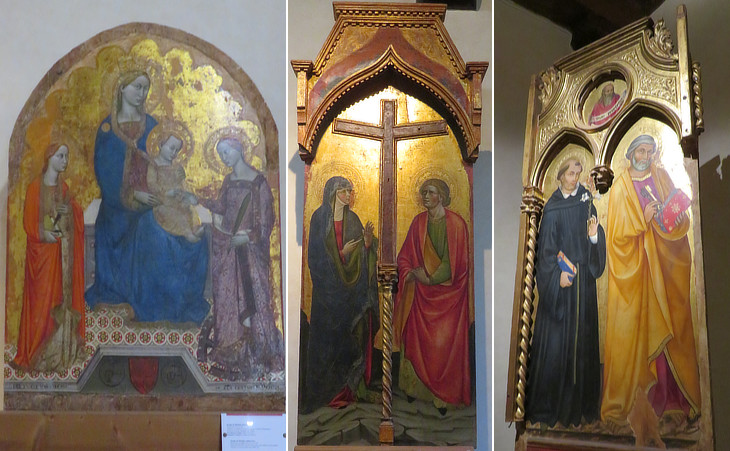
The museum houses a number of interesting gold ground paintings. Jacopo di Michele was a painter of the second half of the XIVth century from Pisa. This town, which is highly reputed for its XIIIth century sculptors, did not develop a school of painting comparable with those of Florence or Siena. Taddeo di Bartolo (1362-1422) was a painter from Siena whose works can be seen in many towns of Tuscany and Umbria.
At the altar of the Maffei family is a picture of the Virgin and Child with saints, by Luca Signorelli; an inscription states that it was a commission from Pietro Belladonna, a monk of the convent, 1491. (..) The oratory of San Carlo in the Cathedral contains an Annunciation by Luca Signorelli, painted in 1491. Murray
We have now arrived at the paintings belonging to the year 1491, part of which Signorelli spent in Volterra, three works still remaining in that city to testify to the visit. Virgin and Saints. In the less ruined parts enough remains to testify to the original excellence of the painting, which is finely composed, and broadly and vigorously treated, especially in the draperies. The Virgin sits enthroned between four saints, with a very Peruginesque angel on either side, and seated below, at the foot of her throne, are two Fathers of the Church, (..) In better preservation is the "Annunciation," in the Cathedral, signed, and with the same date as the foregoing. The architecture, with its excellent perspective, again reminds us that Signorelli was the pupil of Piero della Francesca. The Virgin is painted with great feeling, and in the solemn beauty of the Archangel we get the first of those splendid creatures whose sublimity Signorelli felt in the same spirit as Dante, who bent his knees and folded his hands at the sight of the "Uccel divino" (the Angel).
Maud Cruttwell - Luca Signorelli - 1899
What high solemnity in his Volterra "Annunciation" - the flaming sunset sky, the sacred shyness of the Virgin, the awful look of Gabriel!
Bernard Berenson - Central Italian Painters - 1897
You may wish to see the frescoes by Signorelli in the Cathedral of Orvieto (Cappella di S. Brizio) which are regarded as his masterpiece.
The oratory of S. Antonio, erected in 1172, is remarkable for its altar-piece by Domenico Ghirlandajo, representing the Virgin, with St. Antony, abbot, and St. Bartholomew. Murray
Ghirlandaio painted two panels for the Abbey of S. Giusto, a seat of the Order of Camaldoli, without Volterra; these panels, which are wondrously beautiful, he executed at the order of the Magnificent Lorenzo de' Medici, for the reason that the abbey was then held "in commendam " by his son Cardinal Giovanni de' Medici, who was afterwards Pope Leo.
Giorgio Vasari - Lives of the most eminent painters, sculptors and architects - tr. by G. Du C. De Vere - 1913
Ghirlandaio appreciated Masaccio's tactile values, Pollaiuolo's movement, Verrocchio's effects of light, and succeeded in so sugaring down what he adopted from these great masters that the superior philistine* of Florence could say: "There now is a man who knows as much as any of the great men, but can give me something that I can really enjoy! "Bright colour, pretty faces, good likenesses, and the obvious everywhere - attractive and delightful". (..) Ghirlandaio has undeniable charm, and occasionally in portraits his talent, here at its highest, rises above mediocrity.
Bernard Berenson - The Florentine painters of the renaissance - 1896
You may wish to see other paintings by Ghirlandaio in Florence and at Narni.
* philistine, a label Berenson often applied to those who disagreed with his views on art.
The Madonna which Murray attributed to Ghirlandaio is now assigned to another Florentine painter.
DANIELLO, when he was a lad, learned to draw a little from Giovanni Antonio Sodoma, who went at that time to execute certain works in the city of Volterra; and when Sodoma had gone away he made much greater and better proficience under Baldassarre Peruzzi than he had done under the discipline of the other (frescoes of these two painters can be seen at La Farnesina in Rome). But to tell the truth, for all that, he achieved no great success at that time. (..) Wherefore in his first works, which he executed at Volterra, there is evidence of very great, nay, infinite labour, but not yet any promise of a grand or beautiful manner, nor any grace, charm, or invention, such as have been seen at an early hour in many others who have been born to be painters, and who, even in their first beginnings, have shown facility, boldness, and some indication of a good manner. His first works indeed, seem in truth as if done by a melancholic, being full of effort and executed with much patience and expenditure of time. Vasari
Daniele Ricciarelli da Volterra (1509-1566) spent most of his life in Rome where he was admitted to Michelangelo's inner circle. His masterpiece, a Descent from the Cross at SS. TrinitÓ dei Monti is said to have been based on a drawing by Michelangelo. He is also known as il Braghettone for having covered the nudities of the Last Judgement with underpants (braghe).
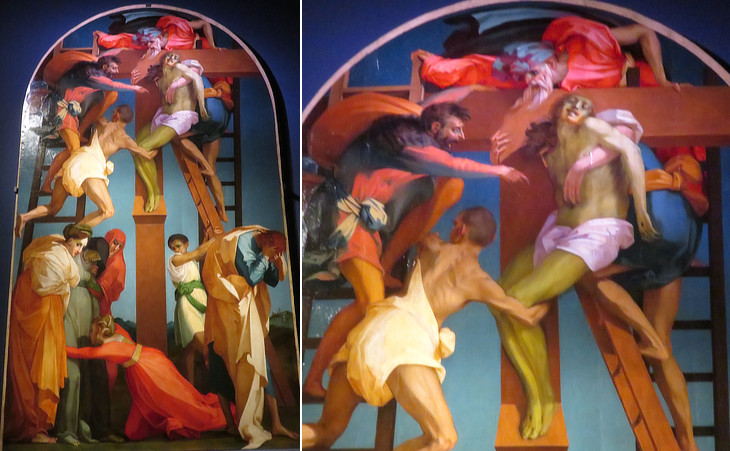
Men of account who apply themselves to the arts and pursue them with all their powers are sometimes exalted and honoured beyond measure, at a moment when it was least expected, before the eyes of all the world, as may be seen clearly from the labours that Il Rosso, a painter of Florence, devoted to the art of painting; for if these were not acknowledged in Rome and Florence by those who could reward them, yet in France he found one to recompense him for them, and that in such sort, that his glory might have sufficed to quench the thirst of the most overweening ambition that could possess the heart of any craftsman, be he who he may. Nor could he have obtained in this life greater dignities, honour, or rank, seeing that he was regarded with favour and much esteemed beyond any other man of his profession by a King so great as is the King of France (Francis I). And, indeed, his merits were such, that, if Fortune had secured less for him, she would have done him a very great wrong, for the reason that Rosso, in addition to his painting, was endowed with a most beautiful presence; his manner of speech was gracious and grave; he was an excellent musician, and had a fine knowledge of philosophy; and what was of greater import than all his other splendid qualities was this, that he always showed the invention of a poet in the grouping of his figures, besides being bold and well-grounded in draughtsmanship, graceful in manner, sublime in the highest flights of imagination, and a master of beautiful composition of scenes. (..) The Director of the Hospital of S. Maria Nuova commissioned him to paint a panel: but when he saw it sketched, having little knowledge of that art, the Saints appeared to him like devils; for it was Rosso's custom in his oil-sketches to give a sort of savage and desperate air to the faces, after which, in finishing them, he would sweeten the expressions and bring them to a proper form. At this the patron fled from his house and would not have the picture, saying that the painter had cheated him.. (..) At Volterra he painted a most lovely Deposition from the Cross. Vasari
The anecdote reported by Vasari applies also to the devilish faces of the men carrying down the body of Jesus. The painting decorated the altar of Cappella della Croce in S. Francesco. It was then moved to the Cathedral and eventually to the Town Museum (where it was restored and given back its bright colours in 2021-2023).
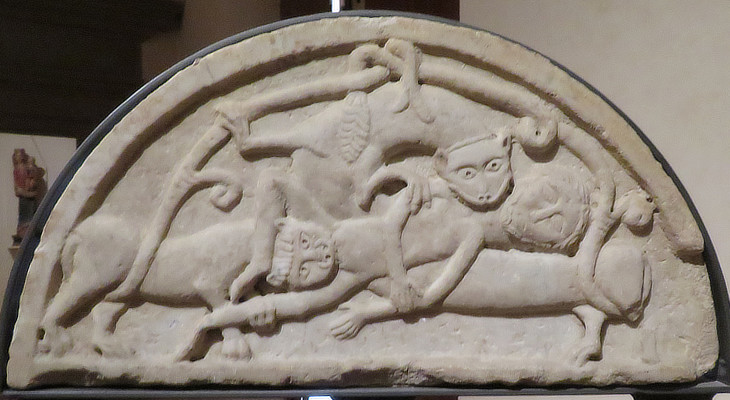
Move to:
Introduction and the Ancient Town
Museo Etrusco Guarnacci
The Medieval Town
In Maremma - other pages:
Corneto (Tarquinia)
Corneto (Tarquinia) - Palazzo Vitelleschi and Museo Archeologico Nazionale di Tarquinia
Tarquinia - Etruscan Necropolis of Monterozzi
Montalto di Castro and Canino
An Excursion to Orbetello
An Excursion to Porto Ercole
An Excursion to Grosseto
An Excursion to Massa Marittima

